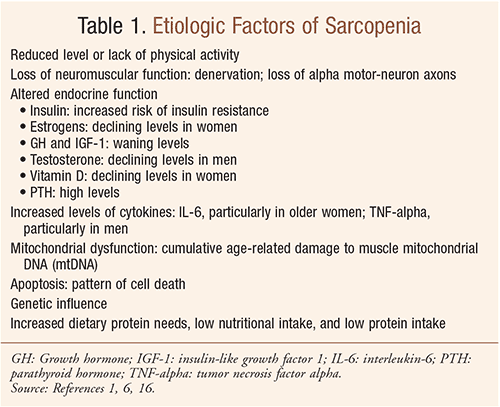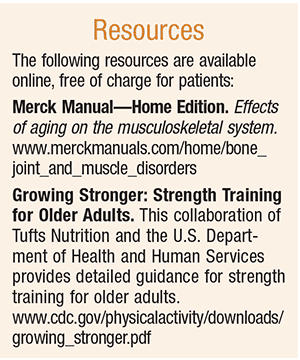Age-related loss of muscle strength, muscle functional quality, and muscle protein mass has come to define the term sarcopenia.1 Typically, this slow and progressive age-related loss of skeletal muscle starts around age 30 years and progresses throughout life, accelerating around age 75 years.2,3 Sarcopenia is an important concept in geriatric healthcare, as it plays a predominant role in frailty, which increases the likelihood of falls, fractures, and hospitalizations that are associated with morbidity, disability, and death.1 For these reasons, this condition affects function and thus negatively impacts independence, which can be devastating to senior adults. Importantly, while clinicians and epidemiologists concur on this theoretical definition of sarcopenia, there has been ongoing development of an operational definition that would be useful throughout clinics, populations, and studies.1
The primary effect from a decline in skeletal muscle mass is reduced muscle strength.1 After the age of 50 years, muscle mass declines at a rate of 1% to 2% per year; but strength declines at a rate of 1.5% per year, and the decline accelerates to as much as 3% per year after the age of 60.4 Several authors have reported that muscle strength, more than muscle mass, is independently associated with physical performance.5
This mild loss of muscle strength places increased stress on certain joints (e.g., the knees) and can predispose an individual to arthritis or falls.2 Sarcopenia is predominantly due to a decline in muscle fiber number. However, the atrophy of fibers, particularly type II fibers—those that contract faster—is also occurring; thus, muscles are not able to contract as quickly in old age. 2,6 There is no generally accepted test or specific level of muscle mass used in the diagnosis of sarcopenia; any loss of muscle mass is of clinical consequence since decline in muscle mass results in loss of strength and mobility.3 Pharmacists are encouraged to use instructional tools regarding the effects of aging on the musculoskeletal system (see Resources) to emphasize the nature of this condition.
Etiological Factors
Multiple risk factors and mechanisms contribute to the development of sarcopenia; important risk factors include lifestyle behaviors, poor diet, and age-related changes in hormones and cytokine levels.1 The interrelated etiological factors (TABLE 1) and onset of sarcopenia are difficult to detect and poorly understood.1 Chronic obstructive pulmonary disease, heart failure, and cancer are chronic conditions associated with an increased level of proinflammatory cytokines and a decline in body weight, including lean body mass; sarcopenia is one of the outcomes of the cytokine-related aging process.1,7 Further, obesity is linked to inflammation and may have a significant role in the development of sarcopenia.8,9

Beneficial Interventions
Sarcopenia is a reversible cause of disability, and is therefore a condition in which patients could benefit from intervention.1 To date, there are no definitive, evidence-based pharmacologic approaches to prevent sarcopenia.1 Resistance strength training (RST)—any exercise that causes the muscles to contract against an external resistance (e.g., dumbbells, rubber exercise tubing) with the expectation of increases in strength, tone, mass, and/or endurance—significantly improves muscle strength, mass, and muscle quality in older adults who engage in this intervention, according to the American College of Sports Medicine (ACSM).1,10
Furthermore, aerobic exercise—the type of moderate-intensity physical activity that one can sustain for more than just a few minutes with the objective of improving cardiorespiratory fitness and health—has been shown to stimulate muscle protein synthesis.1,11 Of note, the muscle protein synthesis rate has been reported to be reduced by 30% in geriatric individuals, although there is controversy regarding the extent to which this reduction is secondary to nutrition, disease, or physical inactivity, rather than to aging.12,13 Further, sarcopenia has been observed in athletes who maintain RST throughout their life span.14,15
Physical activity: When aerobic activities are supplemented with RST exercises at least twice weekly, the following benefits are realized: increased strength; maintenance of bone density; improvement in balance, coordination, and mobility; a reduction in the risks of falling; and maintenance of independence in the performance of activities of daily living. Currently, while sarcopenia is a complex, multifactorial condition, RST is the only treatment that affects the muscular aspects of sarcopenia.1 Overall, by stimulating the growth of muscle and bone, RST exercises are considered essential to staying strong and vital in one’s senior years, helping to prevent osteoporosis and frailty.5,16
RST reduces signs and symptoms of diseases and chronic conditions. For example, RST 1) decreases pain and stiffness and increases strength and flexibility in arthritis; 2) improves glycemic control in diabetes; 3) improves lipid profile and overall fitness, reducing cardiovascular risk in heart disease; and 4) owing to an increase in metabolism, increases calorie burning and assists with long-term weight control in obesity.16
Older patients showing interest in change, including those who are sedentary, can be offered accurate and practical instructional information to commence a program of RST (see Resources). According to Seguin et al, RST benefits men and women of all ages and all levels of fitness, as determined by global research.16 Pharmacists can assist patients who are undertaking RST by counseling them on safe medication use during exercise; see Reference 17 for more information.

Nutrition: Although elderly people may consume adequate amounts of protein, many have a reduced appetite and consume less than the recommended daily allowance for protein, commonly resulting in an accelerated rate of sarcopenia.18 Increasing the intake of protein in the elderly, and especially the frail elderly, can minimize the process of sarcopenia.1,19 Additionally, while endurance exercise increases the requirement for dietary protein, resistance exercise results in a decrease in nitrogen excretion, thus lowering dietary protein needs. Evans indicates that this increased efficiency of protein use may be important for wasting diseases such as HIV infection and cancer and, in particular, for geriatric patients suffering from sarcopenia.18 Further, research has indicated that increased dietary protein intake may enhance the response to RST exercise; in very old men and women the use of a protein-calorie supplement was associated with greater strength and muscle mass gains than was the use of placebo.18 Stimulating protein synthesis requires consideration of the quality and quantity of amino acids (e.g., the essential amino acid leucine); professional nutritional guidance should be considered.
Medications with anabolic activity: Use of anabolic agents to build muscle mass has been suggested in age-related sarcopenia; studies indicate mixed results with exogenous growth hormone, limited and inconsistent effect of estrogen replacement on muscle strength, and lack of dose-response information with testosterone replacement for men with hypogonadism.16
With regard to metabolic syndrome, treatment that is under investigation, if found useful, would augment the effects of RST exercise, not replace them.3 Since sarcopenia is a negative prognostic factor in the treatment of geriatric diabetic patients, pharmacists are encouraged to review the effects of antidiabetic agents on age-related sarcopenia associated with type 2 diabetes (see Reference 20).
Vitamin D: Studies have reported the association between low vitamin D levels and low muscle mass, low muscle strength, decreased balance, and increased risk of falls.21,22 Researchers Janssen et al reported vitamin D deficiency–associated muscle atrophy, predominantly of type II fibers.23 Additionally, one study reported an independent association between low serum vitamin D and sarcopenia.24 Supplementation of vitamin D intake with 700 to 800 IU daily has been shown to decrease the risk of hip fracture and any nonvertebral fracture in elderly community-dwelling and nursing home patients; it also reduces the risk of falls.22,25
ACE inhibitors and cytokine inhibitors: Evidence suggests that ACE inhibitors may prevent sarcopenia; mechanisms may include reducing the level of angiotensin II in vascular muscle cells and interfering with angiotensin II as it relates to an increase in proinflammatory cytokine production.1
Future treatment strategies that consider genetic factors may be developed, yielding a better understanding of the basic pathways underpinning sarcopenia (e.g., expression pattern of genes).1 Basic research also suggests possible opportunities for clinical studies regarding mechanisms of apoptosis, or pattern of cell death.
Conclusion
Pharmacists are in a unique position to recognize a potential condition that is reversible but not currently being addressed. Through consultation with the patient, there is an opportunity to provide advice and guidance to assist the individual in improving clinical status, functional ability, and, ultimately, quality of life. Addressing sarcopenia with older adults may be one such opportunity, and it can be a rewarding one for both the patient and the clinician.
REFERENCES
1. Rolland Y, Vellas B. Sarcopenia. In: Fillit HM, Rockwood K, Woodhouse K, eds. Brocklehurst’s Textbook of Geriatric Medicine and Gerontology. 7th ed. Philadelphia, PA: Saunders Elsevier; 2010:587-593.
2. Merck Manual—Home Edition. Effects of aging on the musculoskeletal system. Last full review/revision July 2014. www.merckmanuals.com/home/bone_joint_and_muscle_disorders/biology_of_the_musculoskeletal_system/effects_of_aging_on_the_musculoskeletal_system.html. Accessed April 10, 2015.
3. WebMD. Sarcopenia with aging. Reviewed August 3, 2014. www.webmd.com/healthy-aging/sarcopenia-with-aging?page=2. Accessed April 8, 2015.
4. Vandervoort AA. Aging of the human neuromuscular system. Muscle Nerve. 2002;25(1):17-25.
5. Visser M, Newman AB, Nevitt MC, et al. Health, Aging, and Body Composition Study Research Group. Reexamining the sarcopenia hypothesis. Muscle mass versus muscle strength. Ann N Y Acad Sci. 2000;904:456-461.
6. Gregson CL. Bone and joint aging. In: Fillit HM, Rockwood K, Woodhouse K, eds. Brocklehurst’s Textbook of Geriatric Medicine and Gerontology. 7th ed. Philadelphia, PA: Saunders Elsevier; 2010:121-122.
7. Morley JE, Baumgartner RN. Cytokine-related aging process. J Gerontol A Biol Sci Med Sci. 2004;59(9):M924-M929.
8. Ryan AS, Nicklas BJ. Reductions in plasma cytokine levels with weight loss improve insulin sensitivity in overweight and obese postmenopausal women. Diabetes Care. 2004;27(7):1699-1705.
9. Baumgartner RN, Waters DL. Sarcopenia and sarcopenic obesity. In: Pathy MS, ed. Principles and Practice of Geriatric Medicine. London, England: John Wiley and Sons; 2006.
10. WebMD. Resistance training. eMedicinehealth. www.emedicinehealth.com/strength_training/article_em.htm. Accessed April 22, 2015.
11. WebMD. Aerobic exercise. eMedicinehealth. www.emedicinehealth.com/aerobic_exercise/article_em.htm. Accessed April 22, 2015.
12. Chaput JP, Lord C, Cloutier M, et al. Relationship between antioxidant intakes and class I sarcopenia in elderly men and women. J Nutr Health Aging. 2007;11(4):363-369.
13. Lord C, Chaput JP, Aubertin-Leheudre M, et al. Dietary animal protein intake: association with muscle mass index in older women. J Nutr Health Aging. 2007;11(5):383-387.
14. Hameed M, Harridge SD, Goldspink G. Sarcopenia and hypertrophy: a role for insulin-like growth factor-1 in aged muscle? Exerc Sport Sci Rev. 2002;30(1):15-19.
15. Trappe S. Master athletes. Int J Sport Nutr Exerc Metab. 2001;11(suppl):S196-S207.
16. Seguin RA, Epping JN, Buchner DM, et al. Growing Stronger: Strength Training for Older Adults. Tufts Nutrition and the U.S. Department of Health and Human Services, Centers for Disease Control and Prevention. 2002. www.cdc.gov/physicalactivity/downloads/growing_stronger.pdf. Accessed April 10, 2015.
17. Zagaria MA. Sarcopenia: loss of muscle mass in older adults. US Pharm. 2010;35(9):24-30.
18. Evans WJ. Protein nutrition, exercise and aging. J Am Coll Nutr. 2004;23(6 suppl):601S-609S.
19. Paddon-Jones D, Rasmussen BB. Dietary protein recommendations and the prevention of sarcopenia: protein, amino acid metabolism and therapy. Curr Opin Clin Nutr Metab Care. 2009;12(1):86-90.
20. Cetrone M, Mele A, Tricarico D. Effects of the antidiabetic drugs on the age-related atrophy and sarcopenia associated with diabetes type II. Curr Diabetes Rev. 2014;10(4):231-237.
21. Szulc P, Duboeuf F, Marchand F, Delmas PD. Hormonal and lifestyle determinants of appendicular skeletal muscle mass in men: the MINOS study. Am J Clin Nutr. 2004;80(2):496-503.
22. Bischoff-Ferrari HA, Dawson-Hughes B, Willett WC, et al. Effect of Vitamin D on falls: a meta-analysis. JAMA. 2004;291(16):1999-2006.
23. Janssen HC, Samson MM, Verhaar HJ. Vitamin D deficiency, muscle function, and falls in elderly people. Am J Clin Nutr. 2002;75(4):611-615.
24. Visser M, Deeg DJ, Lips P. Low vitamin D and high parathyroid hormone levels as determinants of loss of muscle strength and muscle mass (sarcopenia): the Longitudinal Aging Study Amsterdam. J Clin Endocrinol Metab. 2003;88(12):5766-5772.
25. Bischoff-Ferrari HA, Willett WC, Wong JB, et al. Fracture prevention with vitamin D supplementation: a meta-analysis of randomized controlled trials. JAMA. 2005;293(18):2257-2264.
To comment on this article, contact rdavidson@uspharmacist.com.





